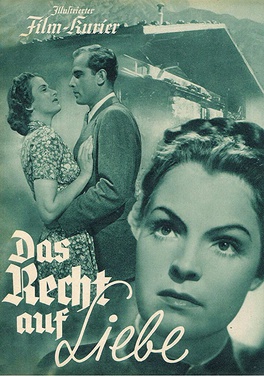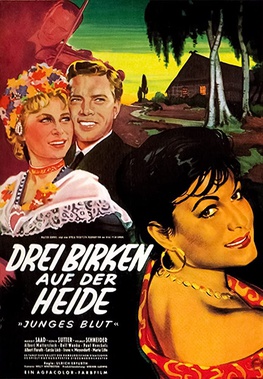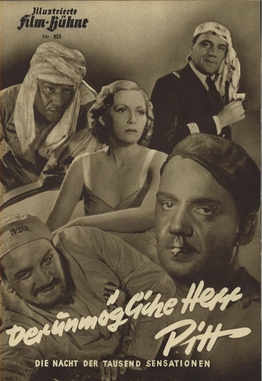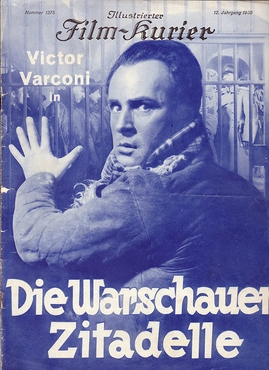
Willi Schulz is a German former footballer who played as a defender for Schalke 04 and Hamburger SV. At International level, he made 66 appearances for the West Germany national team.

Under False Flag is a 1932 German spy thriller film directed by Johannes Meyer and starring Charlotte Susa, Gustav Fröhlich and Friedrich Kayssler. It was shot at the Johannisthal Studios in Berlin from the end of November 1931 to the beginning of 1932. It was made by Deutsche Universal, the German branch of Universal Pictures, in co-production with Tobis Film. The film's sets were designed by the art director Otto Hunte. It premiered at Berlin's Ufa-Palast am Zoo. The film was based on the novel of the same title by Max W. Kimmich, who also worked on the screenplay.

Three Men in a Boat is a 1961 Austrian-West German comedy film directed by Helmut Weiss and starring Walter Giller, Heinz Erhardt, Hans-Joachim Kulenkampff and Susanne Cramer. The film is based on the 1889 British novel Three Men in a Boat by Jerome K. Jerome. It was shot at the Rosenhügel Studios in Vienna and on location in Amsterdam and along the River Rhine through the Rhineland region and Baden-Württemberg of Germany and Switzerland. The film's sets were designed by the veteran art director Willi Herrmann.
Father Vojtech is a 1936 Czech drama film directed by Martin Frič. It is a remake of the 1929 film also called Father Vojtech, which in turn was based on the 1902 novel "Páter Vojtěch : vesnický příběh" written by Jan Klecanda. It was released on 18 December 1936 in Czechoslovakia.

Rolf Wanka was an Austrian actor.
A Step into the Darkness is a 1938 Czech criminal-comedy film directed by Martin Frič. The film was dubbed to German and released under the name Schritt ins Dunkel in 1943.
Ooh… diese Ferien is a 1958 Austrian film directed by Franz Antel.
Poslíček lásky is a 1937 Czechoslovak romance film, directed by Miroslav Cikán. It stars Rolf Wanka, Hana Vítová, Jindřich Plachta.

Not a Word About Love is a 1937 Czechoslovak-German romantic comedy film directed by Miroslav Cikán and Alwin Elling and starring Ellen Schwanneke, Rolf Wanka and Richard Romanowsky. It is the German-language version of Poslíček lásky.

The War of the Oxen is a 1943 German historical film directed by Hans Deppe and starring Elfriede Datzig, Paul Richter and Wastl Lichtmanegger. It is an adaptation of Ludwig Ganghofer's 1914 novel of the same title.

My Leopold is a 1955 West German comedy film directed by Géza von Bolváry and starring Paul Hörbiger, Peer Schmidt, and Ingeborg Körner. It is based on Adolphe L'Arronge's 1873 play of the same name which has been turned into a number of films. It was shot at the Tempelhof Studios in West Berlin. The film's sets were designed by the art director Hans Kuhnert.

The Cloister of Martins is a 1951 West German drama film directed by Richard Häussler and starring Willy Rösner, Gisela Fackeldey and Heinz Engelmann. Based on the novel of the same title by Ludwig Ganghofer, it was part of the postwar wave of heimatfilm movies in Germany. It was shot at the Bavaria Studios in Munich and on location around Königssee and Karwendel in the Alps. The film's sets were designed by the art directors Willi Horn and Carl Ludwig Kirmse.

Irca's Romance is a 1936 Czech romance film directed by Karel Hašler and starring Jiřina Steimarová, Rolf Wanka and Theodor Pištěk. It was one of several Czech films of the 1930s to involve a trip to an Adriatic resort. A separate German-language version Escape to the Adriatic was made in a co-production with Austria.

Youth is a 1922 German silent film directed by Fred Sauer and starring Grete Reinwald, Fritz Schulz and Fritz Rasp.

The Right to Love is a 1939 German drama film directed by Joe Stöckel and starring Magda Schneider, Anneliese Uhlig and Viktor Staal. Location shooting took place in the Tyrol.

Three Birch Trees on the Heath is a 1956 West German drama film directed by Ulrich Erfurth and starring Margit Saad, Sonja Sutter and Helmuth Schneider. It was one of 54 heimatfilm produced that year, as the genre's popularity reached its peak.

The Impossible Mister Pitt is a 1938 German adventure crime film directed by and starring Harry Piel. It also features Willi Schur, Leopold von Ledebur and Hilde Weissner. It was shot at the Babelsberg Studios in Berlin and on location off the coast of Split in Croatia. The film's sets were designed by the art directors Otto Erdmann and Hans Sohnle. It was based on the novel of the same title by Georg Mühlen-Schulte who also worked on the screenplay.

The Citadel of Warsaw is a 1930 German historical drama film directed by Jacob Fleck and Luise Fleck and starring Victor Varconi, La Jana and Adam Brodzisz. The film's sets were designed by the art directors Willi Herrmann and Herbert O. Phillips. It was based on the play Tamten by Gabriela Zapolska, subsequently remade as the 1937 film The Citadel of Warsaw.

Rózsi Csikós (1917–1992) was a Hungarian stage and film actress. She appeared at a variety of theatres including the Budapesti Operettszínház and established herself as a leading soubrette. During the 1930s and 1940s she appeared in several films. She was married to the composer Szabolcs Fényes.

Roses from the South is a 1934 German historical musical film directed by Walter Janssen and starring Paul Hörbiger, Gretl Theimer and Rózsi Csikós. Location shooting took place around Vienna. The film's sets were designed by the art directors Wilhelm Depenau and Erich Zander. It is an operetta film, a popular genre during the decade. The title references the waltz of the same title composed by Johann Strauss.
















